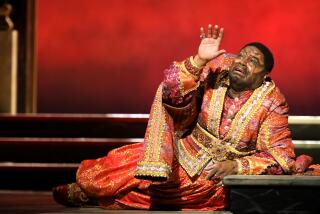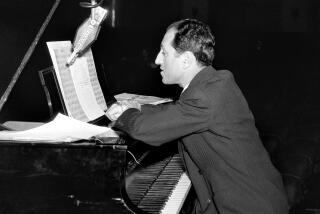Jazz-classical fusion a work in progress
Jazz people like to brag that their idiom is “America’s classical music.” But if you catch some of them in a certain mood, you’ll find that they long to merge their art with what much of the Western world calls “classical music” — the idiom that gave you Mozart, Beethoven, Wagner, etc. The reverse is also true — classical musicians who want to get down with the jazz folk, to learn their freewheeling ways or merely steal a few licks and vamps for their own purposes.
Indeed, Walt Disney Concert Hall will be hosting two such high-profile fusions this winter. On Friday, pianist Brad Mehldau comes in with a jazz combo (including the eminent saxophonist Joshua Redman) and a chamber orchestra conducted by Scott Yoo to perform Mehldau’s recent austerely lyrical double album, “Highway Rider.” On Feb. 12 and 13, the ever-prolific trumpeter Wynton Marsalis merges his Jazz at Lincoln Center Orchestra with Leonard Slatkin and the Los Angeles Philharmonic in his “Swing Symphony” — which like “All Rise,” an earlier Marsalis piece played by the Philharmonic in 2001, attempts to shoehorn the history of acoustic jazz into a sprawling, exuberant, every-which-way symphonic context. Mehldau and Marsalis have worked on both sides of the fence — Marsalis once famously juggled a classical trumpet career with jazz; Mehldau wrote classical song cycles for Renée Fleming and Anne-Sofie von Otter — so their fusions are inevitable outgrowths of their diverse interests.
Yet a persistent question about such fusions lingers: Why even bother?
In a way, the classical-jazz fusion is like an affair between people with such incompatible core traits that one wonders how they manage to tolerate each other at all. The union is fraught with two fundamental contradictions. Jazz started out as, and mostly remains, an improvised music, whereas improvisation went out of style in European classical music centuries ago and has yet to make a widespread return (aside from anomalies like Lutoslawski’s limited free-form passages and Gabriela Montero’s encores). And then there is the crucial issue of pulse, for classical music has its own distinct rhythms that often don’t quite fit into what in jazz is called swing, or a groove.
One motivation for jazz musicians, perhaps not as prevalent today as it was in the 20th century, was a perception among Americans that European classical music is something to aspire to, a reminder of jazz’s origin in the streets and the brothels. For classical musicians, jazz represented freedom — from the printed page literally but also from the strictures of what used to be called polite society. The trick is, then, how do you lift a classical organization off the ground to make it swing, and how can you make jazz players give up some of their freedom of movement while still sounding spontaneous?
They’re still working on it — with varying degrees of success.
While Gunther Schuller’s tag, Third Stream — classical and jazz tributaries merging to form another river — placed a label on classical-jazz fusions in 1957, examples of classical musicians raiding African influences exist even before jazz came to be. One can trace them as far back as Louis Moreau Gottschalk’s piano music before the Civil War, then forward to Charles Ives’ irreverent injections of disruptive ragtime in “ Central Park in the Dark,” Debussy’s “Golliwog’s Cakewalk” and Stravinsky’s “L’Histoire du Soldat.” Between the world wars, incorporating jazz into concert works became an international vogue — affecting domestic and European composers as diverse as Copland, Ravel, Kurt Weill, Erwin Schulhoff and even Shostakovich.
Meanwhile, on the other side of the divide, Artie Shaw tried to meld a string quartet into his first big band, and Stan Kenton stirred more controversy than his usual quota with his Innovations in Modern Music Orchestra, making grandiose, sometimes dissonant, often thrilling entries into the sound worlds of Hindemith and Stravinsky. Dave Brubeck incorporated the polytonality of his teacher Darius Milhaud and the counterpoint of Bach into his singular jazz style, and his later religious works for chorus, orchestra and jazz combo expanded his range even more.
George Gershwin’s “Rhapsody in Blue,” perhaps the most famous classical-jazz piece, actually started its life as a true if accidental combination of classical rigor and jazz spontaneity. Gershwin didn’t have time to write out his piano part for the premiere, so he left spaces for himself to improvise. Only recently, many decades after the written-out version became the standard, have pianists like Marcus Roberts and the unlikely duo of Herbie Hancock and Lang Lang put the idea of improv back into the “Rhapsody.”
By and large, though, Third Stream music — or whatever you want to call it — has never really been at the vanguard of either jazz or classical music since the 1920s and ‘30s. There was always something more glamorous, provocative or intimidating in the way — like agitated free jazz and the energy and color of jazz-rock, or serialism and minimalism on the classical end.
Sometimes the fusions leaned too far in one direction or another, avoiding a true union. Other times, the sides managed to strike a good balance, yet one didn’t hear any ideas worth listening to more than once — a problem shared by a lot of music old and new.
Nevertheless, jazz and classical musicians still try to work out their differences to this day. It’s somewhat easier now, for jazz is an accepted, even respectable resident of academia, and generations of musicians who grew up with records, CDs and MP3s create and play original music that jumps boundaries as naturally as breathing.
Kristjan Jarvi and his Absolute Ensemble’s collaboration with Joe Zawinul on his last studio album, “Absolute Zawinul,” and Vince Mendoza conducting the Netherlands’ Metropole Orchestra and electric guitarist John Scofield on “54” are but two examples of exciting, uninhibitedly executed fusions that were released just last year. And there are little-known treasures from the past awaiting rediscovery — like Rolf Liebermann’s Concerto for Jazz Band and Orchestra, written for Fritz Reiner, the Chicago Symphony and the Sauter-Finegan Orchestra (it’s hard to imagine that old taskmaster Reiner bobbing and weaving to the piece’s wild atonal mambo finale, but that’s what their recording suggests), or Bob Graettinger’s strange, still-radical-sounding pieces for Kenton.
Yet if there is any one project that can be called one of the purest expressions of a classical-jazz fusion — where both sides were satisfied — a good choice would be tenor saxophonist Stan Getz’s 1961 album “Focus.” Here, Eddie Sauter — the same fellow from the above-mentioned Sauter-Finegan Orchestra — composed a suite of seven pieces for string orchestra and had Getz improvise over them whenever he felt like it, without a single written note nor cues to come in. Sauter’s inspired writing and Getz’s instincts resulted in a scintillating recording that swung, challenged its listeners, and contained plenty of attractive, memorable ideas. This is a worthy goal — and it ain’t easy to do.
More to Read
The biggest entertainment stories
Get our big stories about Hollywood, film, television, music, arts, culture and more right in your inbox as soon as they publish.
You may occasionally receive promotional content from the Los Angeles Times.






